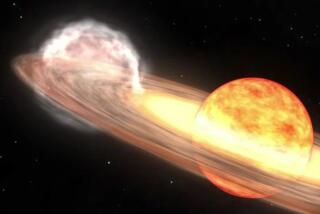Spot Puts Twinkle in Astronomers’ Eyes
- Share via
Astronomers at the Cerro Tololo Inter-American Observatory in Chile have trained their telescopes on a brightening spot in the southern sky in anticipation of seeing something that happens only about once every 1,000 years in the Milky Way’s nearest neighbor: the explosion of a star into a supernova.
Supernovas, in even the most distant reaches of the universe, can be detected because they frequently shine as brightly as entire galaxies, emitting as much energy in one day as the sun does in a million years. But they are much dimmer and more difficult to study because they are usually hundreds of millions--if not billions--of light years away.
Astronomers have been hoping for years to turn their modern tools on a supernova in the Milky Way, but none has been observed since 1604.
“This is the next best place,” Robert Williams, director of Cerro Tololo, said in a telephone interview Tuesday as he discussed the discovery of what appears to be a supernova in the Magellanic Cloud, the galaxy closest to our own.
Williams said Cerro Tololo, which has a four-meter telescope, one of the largest in the world, will track the star for the next couple of weeks. If it is indeed a supernova, it will continually brighten over the next few days until it rivals Jupiter and Venus as the brightest object in the southern sky, he said.
It is too far south, however, to be visible from Southern California.
Supernovas occur when stars die violently in explosions that send debris streaming through space. That debris eventually forms other stars.






